Treasure Island’s Toxic Problem
by CalWatchdog Staff | October 11, 2010 4:16 pm
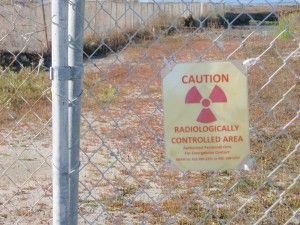 [1]San Francisco’s hottest property may be Treasure Island, where plans for glitzy development are threatened by the Navy’s legacy of radioactive waste
[1]San Francisco’s hottest property may be Treasure Island, where plans for glitzy development are threatened by the Navy’s legacy of radioactive waste
OCT. 12, 2010
By ANTHONY PIGNATARO
SAN FRANCISCO — The jet fighters raced across the sky maybe 500 feet above me. They were F-18s painted blue and yellow – the U.S. Navy’s Blue Angels aerobatics team. They raced across San Francisco Bay last Thursday, alone and in pairs, splitting and diving and rolling and occasionally forming into up into four-ship diamonds so tightly packed it looked like a person could step from plane to plane.
The jets were practicing for an air show so the Navy could show off what it considers the very best in personnel, training and equipment. Their presence over the old Treasure Island Naval Station that day was ironic, because I was visiting the island to see the Navy at its most decrepit and toxic.
Turns out that old Treasure Island Naval Station is some of the hottest property in San Francisco. Maybe the hottest, in fact, though not in the way reuse officials, politicians and land developers want to admit.
That’s because a disputed portion of Treasure Island – the Navy says just a few sites, others say possibly the entire island – is radioactive. What to do about the radiological contamination has become the great unmentionable in the quest to turn the old, rapidly decaying base into San Francisco’s “premier date-night locale,” as one aide to Mayor (and Lieutenant Governor candidate) Gavin Newsom recently put it.
The extent of the danger posed by what lay behind the fences and radiation hazard signs isn’t something the Navy likes to talk about. At public hearings of the Restoration Advisory Board (RAB) – a citizens panel that observes all base cleanup efforts, but takes no action – Navy officials and contractors go to great lengths to say all is well, that there are only a few radioactive sites on the island, and cleanup efforts are proceeding at pace, even though the Navy is well behind schedule.
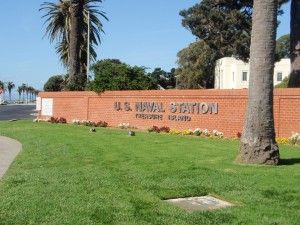 [2]
[2]THE ISLAND'S ENTRANCE
“The overall cleanup is going very well,” said Nathan Brennan, a member of the Treasure Island RAB. “The project was supposed to take one year, but we’re going into year three. They have to go deeper, and they keep finding a little more, a little more. But the Navy is hoping to finish soil cleanup in six to eight months.”
And yet after I made two phone calls to the Defense Department’s Base Closure and Realignment Commission[3] (which the Defense Department inexplicably condenses into the acronym BRAC) — the office that handles all base reuse issues — asking for the status of the radiological cleanup, all I received was a terse, dismissive statement by e-mail.
“The Navy has a Radiological investigation and cleanup Program at former Naval Station Treasure Island, conducted in coordination with the State of California and the U.S. EPA,” said Jim Sullivan, BRAC’s Environmental Coordinator for Treasure Island. “Copies of reports are available in the Information Repositories at the Navy Caretaker Site Office at Treasure Island, and at the San Francisco Main Public Library. The Navy provides information updates on the entire cleanup program at the bimonthly Restoration Advisory Board (RAB) meetings, held on the third Thursday of every second month at 7:00 pm on Treasure Island.”
Others, one of whom agreed to speak anonymously because the person is not authorized to talk to the press, said something very different.
“Radiological waste is a huge variable,” said one person closely tied to the clean-up efforts. “The groundwater is very high – remember, you can put very activated material in a foot of water and not see it. There’s just no way to know if the whole island is toxic.”
* * *
Visitors to the man-made, 403-acre island these days see nothing but charm and opportunity at the entrance. There, palm trees sway over a marina, snack bar and an old art deco administration building that doubled for Berlin Airport in the movie Indiana Jones and the Last Crusade. Banners proclaiming “Treasure Island: Your Recreation Destination” flutter in the breeze.
The city of San Francisco has big, $6 billion plans for TI. A 60-story high-rise. Swanky hotels. Eight thousand new housing units and condos – some for low-income residents, but many for the upper tax brackets. Gorgeous parks, too. At a ceremony in August, Mayor Newsom called it “arguably the most environmentally friendly infill development in American history.” (Newsom’s office didn’t respond to a request for comment for this story).
For San Francisco, the future of Treasure Island looks a lot like its very distant past. The island didn’t exist before 1936. That’s when the federal Works Progress Administration (WPA) began dumping 30 million cubic yards of fill into the waters just north of Yerba Buena Island. The island’s original purpose was to house the 1939 Golden Gate International Exposition, a kind of world’s fair. After the fair there was talk of paving it over entirely and turning it into San Francisco Airport, but that proved to be just talk. In 1941, the Navy took over the island as part of America’s massive war mobilization. They held it until 1997, when it closed as part of the Pentagon’s base closure efforts to save money.
During the five decades the Navy controlled the base, they used it for a variety of tasks – most notably, for the purposes of this story, as a training center for nuclear decontamination. That began in 1947, according to the Navy’s 250-page Treasure Island Naval Station Historical Radiological Assessment[4], released in February 2006.
“Of more significance relative to TI, was the recognition of the need to prepare for the potential of atomic warfare,” states the Assessment. “Command History for the period 1 October 1946 to 10 December 1946 reported that a letter was received from the Bureau of Naval Personnel that directed setting up a course in Radiological Safety to furnish naval officers with the specialized training necessary to evaluate and combat atomic weapon damage. In January of 1947 the fourth floor of the Damage Control School, Building #7, was converted into a suitable location for the Radiological Safety School. The facility consisted of three lecture rooms, a laboratory suitable for demonstrating practical exercises, a meter repair and stowage room, and a room for storing a radioactive source needed for the practical exercises.”
This was a time of nuclear bomb tests in the Pacific, and the Navy needed to clean its target ships before it could study them. All wars, it seemed in these early days of the Cold War, were going to be atomic wars, and the Navy needed to know how to operate in such environments.
According to Nathan Brennan, a member of the Treasure Island RAB, part of the training involved the hiding of radioactive buttons around the training school, and then students armed with Geiger counters would try to find them. At first, things seemed to go well. But then in January 1950 (the Assessment does not give the exact date), someone spilled 40 milligrams of radium in a first-floor lab of Building 233.
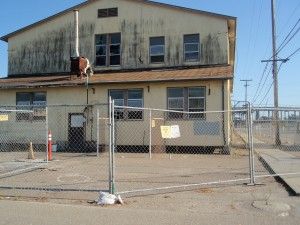 [5]
[5]BUILDING 233, AS IT LOOKS TODAY
“Since many of the occupants of Building 233 left the building before the extent of the spill was full identified, radioactive contamination was carried by personnel (on shoes, clothing etc) to personal automobiles and personal residences,” states the Assessment. “Numerous innovative decontamination techniques were utilized to control and contain and eventually remove the radium contamination… More than 200 barrels of radioactive waste were generated and were stored aboard the USS Independence at Hunters Point Shipyard. The drums were weighted with concrete and were sunk at sea at a depth of more than 100 fathoms.”
Cleanup of the building, which was done to the far less stringent standards of 1950, took about six months.
Of course, that was 60 years ago. “Any radionuclide that could have decayed through 10 half-lives since its time of use at NAVSTA TI is no longer considered a radionuclide of concern,” the Assessment helpfully notes. But then there’s the Assessment’s table of “Radionuclides of Concern,” which lists 14 isotopes, including Cesium-137, Thorium-232, Radium-226, Strontium-90 and the ever-popular Plutonium-239, that all made an appearance at one time or another on the Treasure Island base. These isotopes, some with half-lives in excess of a thousand years, are all still a big concern.
* * *
Redevelopment officials and contractors have a lot of work ahead of them. Throughout much of TI, buildings that look like they date to the Roosevelt Administration stand shuttered and crumbling. Asbestos signs are everywhere. On the island’s northwest corner, where streets named for fish intersect avenues named after letters of the alphabet, there are 600 low-income homes[6], packed with cars, people and – on the day I visited – at least three San Francisco police cruisers.
I drove around, just looking. I made a left, another left, then a right. I found myself near the water’s edge, headed down a dead-end street. I drove to the end, then pulled over to the side. A chain-link fence stretched across the road, just a few feet from one house. There was a small yellow sign with a very distinctive triangular symbol hanging on the fence. “CAUTION,” it warned. “RADIOLOGICALLY CONTROLLED AREA.”
This was what the Navy calls Site 12. Before the twisting streets and cramped houses went in the 1960s, this area held a lot of dump sites – and the sailors weren’t too discriminating about what they tossed here.
“They’ve found objects there,” Brennan told me. “When they found them, they’d go through the yards and dig.”
The fact that contractors have been finding radiological debris in Site 12 is not a good sign. The 2006 Historical Assessment had concluded that contamination in this area was an “unlikely” possibility, but did recommend that the Navy “Perform radiation monitoring during soil excavation of the known solid waste disposal areas.”
At the last RAB meeting, held Aug. 17 on the island, a woman stood up and asked BRAC Environmental Coordinator Sullivan if it was true that the Navy had agreed that if they did indeed get radioactive hits in Site 12, then they would screen all of the island’s other debris sites.
“Yeah,” Sullivan said, according to the verbatim minutes of the meeting. “[I]f radiological material was found in Site 12, then the Navy would conduct additional evaluations of additional sites where debris had been identified.”
To the source close to the cleanup, this pointed to an ominous reality. “Everywhere they’ve looked for RAD, they’ve found RAD,” the source said.
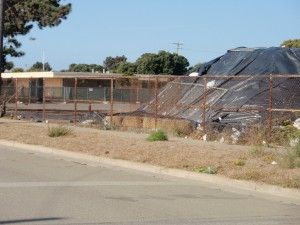 [7]
[7]TOXIC PILES (NOTE SCHOOL IN BACKGROUND)
One of the new sites the Navy is looking at is called Site 31. But before we get there, let’s look at some of the other agencies overseeing the TI cleanup. Two of them in particular, the California Department of Public Health (CDPH) and the California Department of Toxic Substances Control (DTSC), have been, well, skeptical of the work so far.
“To say that they’ve been skeptical is an understatement,” the source close to the cleanup told me.
CDPH Spokesman Ron Owens didn’t return a phone call asking for comment for this story. And the DTSC provided only a boilerplate e-mailed response to my inquiry about their view of the cleanup.
“DTSC is the lead state regulatory agency overseeing the cleanup of the Treasure Island Site,” read part of the response. “We continue to work with the Navy, their contractors, the community and other regulatory agencies… to ensure that the Site is adequately characterized and cleaned up. Additionally, DTSC and the other regulatory agencies oversee the work done by the Navy and it’s (sic) contractors to ensure that it is conducted in accordance with approved protocols in a manner that is adequately protective of public health and the environment.”
I thought of this thoroughly unhelpful answer to my question as I visited Site 31, which is near the center of the island. It’s a big field – next to an elementary school, of all things – and contains immense piles of dirt, some covered with black tarps, others not. “Hazardous Waste Exclusion Zone” read a large sign on the fence surrounding the field. There are, as yet, no radiation signs there.
CDPH and DTSC officials know there’s trouble here. They may not be willing to talk to me about it, but according to the minutes of the Sept. 1 BRAC Cleanup Team meeting – which was not open to the public – they’re the only ones really asking questions about radiological contamination.
“Ms. (Remedios) Sunga (of the DTSC) asked when the revised work plan addendum for Sites 31 and 33 would be ready,” states the minutes. “Mr. (Scott) Anderson (of the Navy) said the contract was just awarded and a schedule has not been finalized. Ms. Sunga asked if radiological work would be included at Sites 31 and 33. Mr. Anderson replied that radiological work would be included at Site 31 and dependent on what was found, Site 33 would be addressed accordingly.”
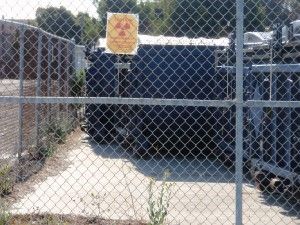 [8]
[8]THE BLUE BINS OF SITE 6
And so on. Then the discussion moved to Site 6, which is a storage yard for large blue dumpsters that house radioactive debris before it’s shipped off island and out of state. There, radiation hazard signs hang all over the surrounding fence. So far, cleanup crews have filled 705 of these “bins” and shipped them to Clive, Utah, one of only two landfills in the country that dispose of low-level radioactive waste.
“Ms. Sunga asked if the Navy was using all of Site 6 to store radiologically impacted soil,” the minutes show. “Mr. (Anthony) Konzen (of the Navy) said it is not. Mr. (Guy) Taibi (of the CDPH) asked if there was scanning outside the fenced area. Mr. Konzen explained the radiological measures are within the RCA and, in addition, no other burn areas were indicated outside the fenced area.”
But the hottest topic (so to speak) at the Sept. 1 meeting was Building 233 – the old training school where Navy personnel spilled radium back in 1950. This, the most notorious structure in the old base, sits on Avenue M in the eastern corner of the island, which has a spectacular view of the new Bay Bridge construction. BRAC contractors said at the Sept. 1 cleanup team meeting that they’d begin demolishing this building – which is thoroughly contaminated – “by September 20 or 21.”
It’s still standing, with interior walls splattered with graffiti drawn by homeless guys who’d lived in the abandoned building in the years between Navy control and the current cleanup effort. The building’s fenced in and covered in radiation warning signs. Across the street is a little league baseball field.
The Sept. 1 meeting minutes show that Sunga of the DTSC was very concerned about the demolition of the building – especially considering that asbestos removal was also taking place there. “Ms. Sunga said CDPH is concerned about cross contamination in soil when the building is being demolished,” the minutes state. “She asked if the excavator will be crossing through the building footprint or will remain around the perimeter. Mr. (Pete) Bourgeois (of Shaw Environmental Inc., a Navy contractor) said the excavator would be crossing into the footprint but that all equipment working in a radiological controlled environment must be screened before it can leave the area.”
Sunga then asked if they would be removing any underground pipelines as well. Bourgeois said, according to the minutes, that “the Navy would remove only the building itself and anything from the ground down would not be removed until the final status survey plan is approved.”
A few minutes later Taibi of CDPH went back to the issue of what lies beneath Building 233. “Mr. Taibi reiterated the lack of detail in the work plan concerning how the building would be razed caused concern about the soil underneath the building,” state the minutes. Konzen of the Navy then referred Taibi to part of the “Accident Prevention Plan” that deals with the demolition procedure. The minutes show that Taibi “was able to locate the document,” and that the matter apparently ended there.
* * *
There was talk a few years ago of giving the island to the city for free, but like the old plans to build an airport there, it went nowhere. The city eventually agreed to pay $105 million for it – a bargain, in any case.
On Aug. 17, Newsom, Speaker of the House Nancy Pelosi and Navy Secretary Ray Mabus met on Treasure Island to celebrate the signing of an “endorsement agreement” to transfer the island from the Defense Department to the city of San Francisco. But the ceremony – like everything mentioned publicly concerning Treasure Island – was just surface glitz. Indeed, Newsom admitted at the ceremony that the groundbreaking wouldn’t take place until “sometime next year.” At the BRAC Cleanup Team meeting on Sept. 1, Environmental Coordinator Sullivan said, “the actual transfer will depend on the City and the County of San Francisco’s completing the California Environmental Quality Act (CEQA) documentation and that other milestone items will also need to be achieved.”
That means the cleanup has to finish. Considering its importance to the grand plans trumpeted by Newsom et al, it’s strange that the media is largely ignoring the issue. Indeed, the San Francisco Chronicle ran two stories on Treasure Island in August, neither of which even mentioned radiological contamination. Ditto an Oct. 9 story[9] that ran on CBS 13.
“It’s such a hot issue, so to speak,” the source close to the cleanup said. “The Navy would just rather not find it (radiological debris) there. At the end of the day they want to give them (CDPH and DTSC) a package that they’ll love, but it’s not working that way.”
- [Image]: http://www.calwatchdog.com/wp-content/uploads/2010/10/PA070908.jpg
- [Image]: http://www.calwatchdog.com/wp-content/uploads/2010/10/PA070907.jpg
- Base Closure and Realignment Commission: http://www.bracpmo.navy.mil/basepage.aspx?baseid=44&state=California&name=treasure_island
- Treasure Island Naval Station Historical Radiological Assessment: http://www.bracpmo.navy.mil/base_docs/treasure_island/documents/enviro_docs/FinalTI_HRAFeb2006.pdf
- [Image]: http://www.calwatchdog.com/wp-content/uploads/2010/10/PA070914.jpg
- 600 low-income homes: http://www.thevillagesattreasureisland.com/index-3.html
- [Image]: http://www.calwatchdog.com/wp-content/uploads/2010/10/PA070909.jpg
- [Image]: http://www.calwatchdog.com/wp-content/uploads/2010/10/PA070911.jpg
- Oct. 9 story: http://cbs13.com/local/treasure.island.project.2.1954721.html
Source URL: https://calwatchdog.com/2010/10/11/treasure-islands-toxic-problem/